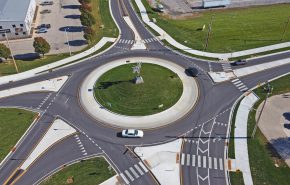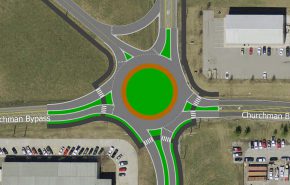Roundabouts vs Traditional Signalized Intersections
Roundabouts provide safe and efficient means of controlling traffic right of way. When two vehicles approach an intersection at the same time, one has to give way to the other. In the U.S., we primarily use either stop signs or traffic signals to manage traffic flow—a roundabout offers a third way of controlling who has the right of way at an intersection.

Slow Down to Go Around
From an operational standpoint, roundabouts have proven safer than traditional intersections. Traffic has to slow down to move through a roundabout, so the severity of crashes is greatly reduced when compared to crashes that occur at signalized intersections, where vehicles are traveling at or in excess of the posted speed.
In addition to causing the driver to slow, roundabouts require him or her to be more engaged. At traditional signalized intersections, drivers move when the light turns green, often without thinking about other vehicles coming from either side. At a roundabout, entering drivers must look to the left to see if anybody is going to come into conflict with them. This makes the driver into an active participant instead of simply reacting to a signal.
Roundabouts also reduce opportunities for crashes. The Roundabout Information Guide, produced by the Federal Highway Administration in 2000 and later updated by the Transportation Research Board, shows in the above diagram how a four-leg single-lane roundabout has 75 percent fewer vehicle conflict points compared to a conventional intersection.
No More Sitting in Traffic
Roundabouts also move traffic much more efficiently. Even though traffic moves slower through roundabouts, it usually continues to flow without long backups. Traditional intersections can cause miles of congestion during peak rush hours.
Roundabout Rules: Slow Down, Look Left, Know Your Exit
Navigating a single-lane roundabout takes three simple steps:
The rules are similar when navigating a multi-lane roundabout, but drivers need to choose an entrance lane based on where they are heading: use the left lane for a left turn and the right lane for a right turn.
Carmel, Indiana: A Roundabout Sensation
The City of Carmel, IN recently celebrated the construction of its 100th roundabout, the most of any city in the U.S. In 1996, Carmel’s Mayor Jim Brainard recognized the benefits of installing roundabouts over traditional intersections in his city. One roundabout succeeded another at all types of intersections, from low-volume residential streets to busy highway interchanges. Along with improved safety for all road users, the new intersections reduced delays, noise, and air pollution. As a bonus, the city estimates that the roundabouts save Carmel’s drivers 2.5 million gallons of gas per year.
By installing roundabouts, many of Carmel’s roads now allow traffic to flow smoothly with fewer lanes, allowing for wider sidewalks, tree-lined medians, and separate bike paths throughout the city. Such improvements elevated Carmel to one of the most livable cities in the U.S.—a safe, walkable, vibrant mixed-use community.
Pennsylvania Street Reconstruction
Carmel, IN
![]()
GAI contributed to Carmel’s roundabout success in an accelerated project that involved reconstructing a two-lane street into a four-lane, boulevard-style street, with a landscaped median and left turn lanes. A roundabout at 103rd Street facilitated traffic flow, and a second roundabout at 106th Street replaced an existing traffic signal.
Read more about GAI’s work with roundabouts and other intersection solutions:
- Peanut Roundabout Cracks Traffic Safety Challenge
- New Roundabout a Point of Pride for Indiana’s City of Beech Grove
- Roundabouts Boost Safety in Pennsylvania and Beyond
- Traffic Engineering Transforms Busy Intersection


